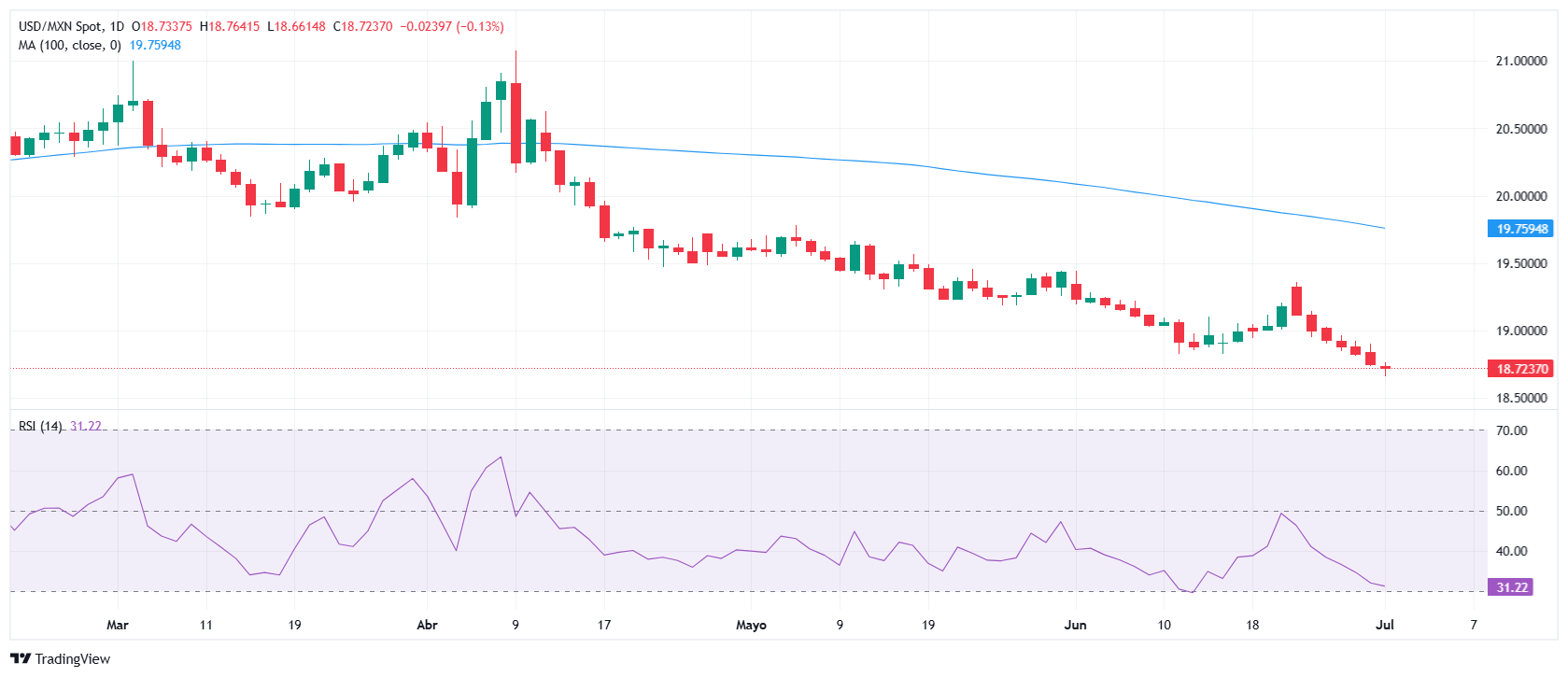- The USD/MXN collapses to new minimums of ten months in 18.66.
- The US dollar shows high fragility weighed by uncertainty around the commercial agreements and the Trump bill deficit.
- The ISM manufacturing PMI and US Jolts employment offers improve expectations but do not change the USD trend.
The USD/MXN records its seventh consecutive losses on Tuesday, something not seen since the beginning of March 2024. The pair has opened the day testing a daily maximum in 18.76, but subsequently has given ground until it falls to a new minimum of ten months before the opening of Wall Street in 18.66.
After touching its lowest price since August 20, 2024, the US dollar is quoted against the Mexican peso in the first bars of the American session over 18.72, losing 0.12% in what we have been in time.
The nervousness to Trump’s policies lead to the dollar to their lowest level since February 2022
The US dollar index (DXY) does not stop giving ground. Nine are the days in which the green ticket fails to register profits, collapsing today to a new floor of three years and four months in 96.38.
After this strong setback, a common denominator, Donald Trump. The policies of the US president are generating high restlessness in the markets. This week, the concerns come from the possible approval of a tax bill Designed to favor the richest at the expense of those who have less, which also implies a high cost in national security. If the ‘Big Beautiful Bill’ achieves the approval of the Senate, the United States could face an increase in debt of 3.3 billion dollars between 2025 and 2034.
Besides, The lack of commercial agreements a few days of July 9, a deadline that Trump set up to reactivate reciprocal tariffs, also generates fears. Only agreements with the United Kingdom have been signed, and partially with China. The rest of the negotiations still run, without any guarantee of getting to fruition.
Added to this, Donald Trump does not stop compromising the independence of the Federal Reserve from the United States, threatening its president Jerome Powell with an early cessation, and publicly insulting it.
The ISM manufacturing PMI and US Jolts employment offers improve expectations
On today’s agenda, the main fact was the PMI manufacturing of the ISM. The indicator has risen to 49 points in June From May 48.5, reaching its highest level in three months although it remains in contraction territory. The figure, however, has improved market expectations, since an increase to 48.8 was expected.
On the other hand, May Jolts employment offers have shown an increase to 7,769,000 since April 7,395,000, exceeding 7,300,000 expected by the market.
Positive data have driven the dollar index (DXY) upwards, placing it around 96.78, although maintaining the losses of the day.
USD/MXN Price levels: the Mexican weight consolidates its upward trend
The 14 -day relative force (RSI) index is very overende in graphics of the USD/MXN of short and medium term, anticipating a rebound, which in any case, should not have much route within the clear bearish trend in all temporal frames.
Downward, a sustained break in the 18.60 area, where are the soils of mid and late August 2024, will take the USD/MXN to the psychological area of 18.00. Below, the key level is 17.70, July minimum 2024.
Upwards, the first resistances are around 18.84/18.96, where the mobile socks of 100 periods in one and four hours are located. Above 19.00, the main barrier will be in 19.35, maximum of the last four weeks.
USD/MXN daily graphics

Mexican weight FAQS
The Mexican weight (MXN) is the most commercialized currency among its Latin American peers. Its value is widely determined by the performance of the Mexican economy, the country’s central bank policy, the amount of foreign investment in the country and even remittance levels sent by Mexicans living abroad, particularly in the United States. Geopolitical trends can also affect MXN: for example, the Nearshoring process (or the decision of some companies to relocate the manufacturing capacity and supply chains closer to their countries of origin) is also considered a catalyst for the Mexican currency, since the country is considered a key manufacturing center in the American continent. Another catalyst for MXN is oil prices, since Mexico is a key exporter of the raw material.
The main objective of the Central Bank of Mexico, also known as Banxico, is to maintain inflation at low and stable levels (in or close to its 3%target, the midpoint of a tolerance band between 2%and 4%). To do this, the bank establishes an adequate level of interest rates. When inflation is too high, Banxico will try to control it by raising interest rates, which makes the indebtedness of homes and companies more cooling, thus cooling the demand and the economy in general. The highest interest rates are generally positive for Mexican weight (MXN), since they lead to higher yields, which makes the country a more attractive place for investors. On the contrary, lower interest rates tend to weaken the MXN.
The publication of macroeconomic data is key to evaluating the state of the economy and can have an impact on the valuation of the Mexican weight (MXN). A strong Mexican economy, based on high economic growth, low unemployment and high confidence is good for MXN. Not only attracts more foreign investment, but it can encourage the Bank of Mexico (Banxico) to increase interest rates, particularly if this fortress is accompanied by high inflation. However, if the economic data is weak, the MXN is likely to depreciate.
As an emerging market currency, the Mexican weight (MXN) tends to rise for periods of risk, or when investors perceive that the general market risks are low and, therefore, are eager to participate in investments that carry a higher risk. On the contrary, the MXN tends to weaken at times of market turbulence or economic uncertainty, since investors tend to sell higher risk assets and flee to the most stable safe shelters.
Source: Fx Street
I am Joshua Winder, a senior-level journalist and editor at World Stock Market. I specialize in covering news related to the stock market and economic trends. With more than 8 years of experience in this field, I have become an expert in financial reporting.







